CONSTELLATION GUIDE
Last updated: 14 July 2003
"GO TO"....CYGNUS
(and surrounding constellations of Delphinius,Sagitta, and Vulpecula)
Scoping in on the Striking Celestial Swan
From: sherrodc@ipa.net (Clay Sherrod)
This ninth Constellation Guide, "GO TO CYGNUS" of the series "GO TO GUIDES for the ETX and LX 90 Telescope Users" takes us RIGHT SMACK in the middle of the beautiful Milky Way galaxy as we explore the famous "North American nebula" and observe the very dark "lane" of obscuring dust in the direction of our neighboring galactic arm of stars. In Cygnus we marvel at the array of wonderful deep sky objects, dense clouds of gravitationally-bound stars, dark obscuring and light-absorbing space dust and wonders beyond imagination. In Cygnus, tiny Delphinius (the "dolphin") Sagitta ("the archer's arrow") and Vulpecula (the "Fox") the star clouds are phenomenal and worthy of very wide field and slow scans throughout the constellation. It is pocked with very bright and contrastingly interesting colored stars, clusters of all types, both bright and dark nebulae and one of the most exciting planetary nebulae - "The Dumbbell Nebula" (Messier 27 in Vulpecula) that you will ever observe.
In addition be prepared for perhaps the most striking double star, Albireo, that you will ever observe in the ETX 60 and larger telescopes. No matter how many times you see this star....you will keep coming back to it. It is truly a showcase object for a star party or your next neighborhood barbecue sky session! But be sure to note that Albireo is by far not the only interesting - even spectacular - double star in Cygnus, Delphinius or Sagitta....there are many, many more worth pursuing. There are few such objects on this GUIDE, but also be sure to consult your AutoStar library in the handbox under "Object/Star/Double...." for more GO TO objects, and find a good atlas for the hundreds more not listed on AutoStar.
You will begin your "GO TO" journey into Cygnus via the bright star Deneb", a nice bright yellow-white supergiant star that is commonly referred to in the "asterism" known as the SUMMER TRIANGLE (below), a nice wide shape bounded by the bright summer stars Deneb (Cygnus), Vega (Lyra) and Altair (Aquila).
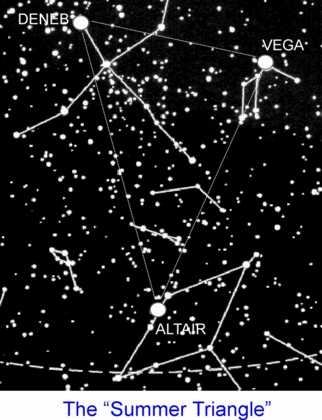
The approximate locations of our lesser constellations - Delphinius, Sagitta and Vulpecula - can be clearly noted from this and the following regional sky chart.
Each GO TO object is discussed for your telescope regarding the type of conditions necessary for you to view it optimally for discern the very faintest details....double star challenges for each size telescope .....magnifications and aperture necessary for most objects, and much, much more. This is YOUR complete GUIDE to pique explore the exciting inner arm of our Milky Way galaxy, its exciting large galactic star clusters, bright emission nebulae and the dark obscuring dust that blocks the otherwise life-threatening radiation from the very center of our galaxy. Use these guides as an excellent reference for your next star party itinerary, or a beginning for further study into the thousands of objects visible in this part of the sky.
Truly these extensive Constellation Study Guides will most definitely put your AutoStar to work for you in the most efficient and enjoyable way possible!
We hope you enjoy these comprehensive GUIDES to touring the constellations via your AutoStar and its computer-driven telescope. Each new installment will appear frequently, complete with diagrams, charts and illustrations that you will find nowhere else. Please let us hear YOUR feedback and your observations of each and every constellation after YOU have toured its vast reaches of our skies!
-----------------------------------
Introduction -
CYGNUS (pronounced "SIG-nus") is often referred to as the "Northern Cross" as its shape denoted by the brighter star members truly do conform to that of a large summer cross overhead. Its counterpart "Crux", or the Southern Cross, is a favorite for observers and even the earliest sea-going navigators through the southern hemisphere skies.
We have discussed in other constellation "GO TO" GUIDES that many constellations did NOT look like their namesakes, and actually neither does Cygnus. Thus, I have always found it remarkable and very curious that the constellation throughout many cultures and times has ALWAYS denoted some time of bird in our celestial aviary. To some it was a crow (now given to "Corvus"), and a peacock.....a swan....and even a chicken. In earliest Arabian writings, the principal star DENEB was titled AL DHAHNAB....or "tail of the hen." It is from this description that the star gets its present name. Still other Arabic labels showed the constellation as a swan, an eagle, a dove....perhaps from earlier Babylonian script.
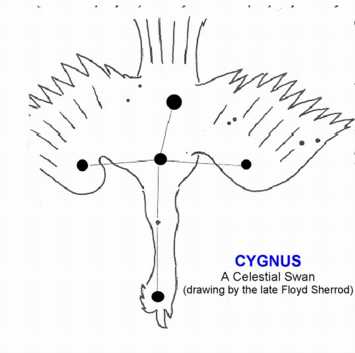
The entire constellation is worthy of very wide field scrutiny and the ETX 60 and 70 are ideal for dark night scanning at their lowest magnifications. For through Cygnus, running the length from the "top" to the "bottom" of the Northern Cross is the magnificent star clouded arm of our Milky Way....but let's NOT stop there. Interrupting this arm's length is an equal length of DARK MATTER, light-obscuring and energy-absorbing dust that blocks both light and high energy from the center of our Milky Way (nearby and south in Sagittarius). On a dark night with the naked eye, and with the low wide field telescopes, this dark cloud is truly remarkable as it literally BLOCKS the light behind it. It appears as a black streak smeared across the expanse of the bright clouds of the Milky Way. Wait until Cygnus has risen very high in the sky and recline for some of the most wonderful views you have ever experienced in this magnificent area. A pair of 7 x 50 or 10 x 50 binoculars will reveal MORE than you could possibly explore in a lifetime in this region!
Look for the crafty FOX (Vulpecula) chasing the "head" of the swan (Albireo), just south of the bottom of the "cross." Sagittarius' errant arrow (Sagitta) is flying just under this fox and south also of Cygnus, while the playful Dolphin of the sky (Delphinius) leaps just southeast of all this from the watery crests of the bright Milky Way. Although only composed of five primary stars, Delphinus is one of the few constellations that actually LOOKS like what it is supposed to be....a leaping Porpoise.
-----------------------------------
YOUR CYGNUS / Delphinius / Sagitta / Vulpecula CONCISE DIRECTORY OF OBJECTS -
This group of summer constellations is full of outstanding and curious objects, stars, clusters, bright AND dark nebulae - from naked eye, to wide field, to telescopic - that is was very difficult to select (and limit) the number of objects for our "GO TO" TOUR.
I have chosen the finest 14 objects in this CYGNUS and surrounding area to showcase for your "GO TO" TOUR; in this case, all objects listed below will be visible in all telescopes (some naked eye) from the ETX 60 through the LX 90; of course larger apertures may "show" an object a bit closer and "better," but frequently a wide field and low power view is more desirable than aperture. This is the case for MANY of these objects since we are looking directly into the very star-cloud-rich areas of our Milky Way galaxy. Indeed, I strongly encourage your to step away from the telescope often and scan the beautiful open skies and star fields with a good pair of 7 x 50 or 10 x 50 binoculars. You will be tempted to venture to your "dark sky site" for a full evening of laying back on a blanket and scanning the skies. The many deep sky objects in the Cygnus area even stand out to the dark-adapted naked eye, and the dark and bright star clouds emerge like in no other area. Once your eyes are fully dark adapted, you will even be able to see such wonders perhaps as the magnificent and very large "North American Nebula" (discussed below), just to the northeast of bright Deneb. Even the binoculars will show dozens of deep sky objects that cannot be fully appreciated in large telescopes with limiting fields of view!
The high northern altitude of Cygnus places it for ideal summertime observing for northern hemisphere skygazers. Rising nearly due east and transiting the meridian only 6 hours later, this constellation affords a full night's observing pleasure and discovery.
As with all of the "GO TO" TOUR constellation lists, I recommend a good star atlas and/or chart which will list all the finest objects, constellation-by-constellation. One very handy reference guide is the PETERSON FIELD GUIDE TO THE STARS AND PLANETS, which features complete lists with declinations, right ascensions, magnitudes, and all pertinent information for you to expand your observing horizons beyond this brief GUIDE.
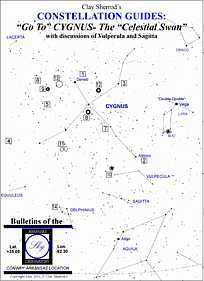
Click for full size version
Note that your AutoStar will NOT have every object listed on every constellation GO TO tour....this is intentional. You can access some of the most interesting objects of the sky directly from their coordinates. It is quite simple as you merely enter these coordinates as follows in the 10-step process:
1) Press the "MODE" key and hold down for 3 seconds and release;
2) Displayed will be the current Right Ascension and Declination of the center of field of view of where your telescope is presently pointed (assuming that you have properly aligned from "home position");
3) [NOTE: if you have the Meade electric focuser attached to any of the ETX or LX telescopes, holding down the "MODE" key will bring up the "Focus" command first....merely scroll (lower right scroll key) down one step to access the RA and DEC to enter your desired coordinates]
4) Press the "GO TO" button on AutoStar;
5) This will change the display and you will note the cursor blinking over the first digit of RIGHT ASCENSION (R.A.); merely use the number keys and dial in the R.A. of the object you are searching for;
6) When done, press "Enter;"
7) This moves the blinking cursor over the "DEC" coordinates;
8) [NOTE: the declination, unlike R.A., can be either positive or negative and you will see the "+" or "-" sign displayed depending on where your telescope is aimed at that time; if it is NOT the desired setting (plus or minus), merely use your arrow key to move the blinking cursor OVER the "+" or "-" sign and change by using either of your lower corner SCROLL KEYS;
9) Proceed to enter the DEC using number keys;
10) Press either "Enter" or "Go To" when finished and the telescope begins slewing to your desired object!!
The constellation tour Star Chart above (click on and save to a file on your PC; then open it and re-size to fit the page and print for a very handy at-the-scope star chart) will get you started on your journey for this constellation.
Following is the complete 14-object list for your "GO TO" TOUR of Scorpius; you may wish to find the majority of the objects from the AutoStar Library (for example, you can easily go to the Dumbbell Nebula if you pull up "Object/Deep Sky/Messier Object/..type in '27'...." and then press "Enter", followed by "GO TO" to access my favorite all time globular cluster. On the other hand, if you want to experiment and become a "better AutoStar user" try entering the exact R.A. and DEC coordinates of that object as described above after holding down the MODE key. You will find the accuracy of entered GO TO's to be somewhat less than those stored in AutoStar, but the capability of acquiring unlisted objects is fantastic!
OBJECT 1:
very bright star - Deneb (alpha Cygni) - R.A. 20h 40' / DEC + 45 06 - Magnitude: 1.2, super giant star
OBJECT 2:
SKY'S BEST DOUBLE - Albireo (beta Cygni) - R.A. 19h 29' / DEC + 27 51 - Mags: 3.0 & 5.1 (wow!!)
OBJECT 3:
Very good double - Delta Cygni - R.A. 19h 43' / DEC + 45 00 - Magnitudes: 3 & 6.5 (great for ETX 60)
OBJECT 4:
Nice close double - Mu Cygni - R.A. 21h 42' / 28 31 - Magnitudes 4.7 & 6.1 - Good test for ETX 90!
OBJECT 5:
Orange Doubles! - 61 Cygni - R.A. 21h 04' / DEC 38 28 - Magnitudes: 5.3 & 5.9 very easy, interesting!!
OBJECT 6:
QUAD star - Nu Scorpii - R.A.16h 09' / DEC (-)19 21 - four stars, two close pairs.
OBJECT 7:
My favorite variable! - SS Cygni - R.A. 21h 41' / DEC + 43 21 - Magnitude range - 8 to 11.7, 51 days!
OBJECT 8:
nice galactic star cluster - Messier 29 (ngc6913) - R.A. 20h 22' / DEC + 38 21 - Mag: 7.1 small & nice
OBJECT 9:
another galactic cluster - Messier 39 - (ngc7092) - R.A. 21h 30' / DEC + 48 13 - Mag: 5.2, 30 stars
OBJECT 10:
DUMBBELL NEBULA - Messier 27 (ngc6853) - R.A. 19h 57' / DEC + 22 35 - (in Vulpecula!)
OBJECT 11:
Interesting diffuse nebulae - ngc6992 & 6960 - R.A. 20h 54' / DEC + 31 30 - the "Veil Nebula!!"
OBJECT 12:
galactic star cluster - ngc6866 - R.A. 20h 02 / DEC + 43 51 - about 50 stars, nice cluster!
OBJECT 13:
NORTH AMERICAN NEBULA - ngc7000 - R.A. 20H 57' / DEC + 44 08 - NEED DARK SKY, no scope!
OBJECT 14:
Very nice double star - Gamma Delphini - R.A. 20h 44' / DEC + 15 57 - Magnitudes: 5.5 & 4.5
---------------------------------
A VISUAL GUIDE TO OUR DEEP SKY OBJECTS IN CYGNUS, Delphinius, Sagitta and Vulpecula -
Object 1 - Very Bright Star Deneb (Alpha Cygni)
Let's start our "GO TO" TOUR of the Cygnus region with a slew to "Object/Stars/Named....DENEB" This is a very deceptive star, appearing of average brightness and shining innocently against the soft glow of the summer Milky Way. But looks can fool. Deneb, at a distance of 1600 light years, is one of the largest SUPERGIANT stars we know of, only equaled by Orion's Rigel which is closer. At the distance of our own sun, Deneb (visual magnitude 1.3 and only the 19th brightest naked eye star) would appear an incredible 60,000 TIMES BRIGHTER! Like Rigel, it is a very "early" star, meaning beginning its evolutionary trail on the Hertzsprung-Russell diagram of star development. To me, this star has always appeared distinctly "yellow" but it is truly a bright white supergiant just like brilliant white Rigel. Just to the east of Deneb is the famous "North American Nebula," a very beautiful reflection nebula at about the same distance from us as Deneb is.....it is thought that the "glow" from this nebula (ngc7000 - see below) is actually a result of energizing from Deneb itself!
Object 2 - the BEST double star of the sky...ALBIREO (beta Cygni) - a wonderful contrast in color!
Although this is one of the most magnificent stellar sites in the cosmos, the name actually means...."nothing." It is an error it appears. Somewhere in the 16th century translations of all the earliest Arabic star and constellation designations, the name originated for this star as "Ab rireo" which really translates to nothing in particular. The actual recorded Arabic gives the star the name of the "Hen's Beak," or "Al minhar al Dajajah." Perhaps that was too difficult with too many "a's".
Albireo, at magnitude 3.1, is the most remarkable of all double stars in color contrast. The brightest star, magnitude 3.1, is clearly a brilliant yellow color, while the smaller (fainter at magnitude 5.1) is a distinct aqua or blue-green color. There is no mistaking the rich color contrast here, even if you are color blind. However, I must warn you that - even thought the star can be easily resolved into the two striking components in LOWEST magnification of the ETX 60 or 70 - you must use about 15x per inch aperture to actually appreciate the saturation of these deep colors. If you get too high a magnification, the color diminishes with the brightness....too low and the effect is gone from the intensity of the stars themselves. Albireo, at a distance of only 410 light years (the exact same distance as the Pleiades of late Autumn!), is much closer than Deneb is to Earth.
Object 3 - Delta Cygni - A Real Test Double for the ETX 90
This star has a primary component of a bright magnitude 2.8 and a secondary star that is only about 2" arc from it at magnitude 6.5, about SSE. At present, this double star is thought to be at maximum separation as seen from Earth, but still presents a challenging object for the ETX 90 scope. It is likely unresolvable in anything smaller. Because of the difference in brightness, the 2nd magnitude star overshines your ability to clearly differentiate the fainter star, so use medium high (about 150x and slightly above) to begin to resolve this star.
Object 4 - Mu Cygni - A good double star....perhaps a severe test for the ETX 60 and 70
This star only ten years ago was a much tougher double to split. However, its apparent separation has been increasing since it was first discovered and is now about its maximum, some 3.2" arc, making it an ideal test object for high power with the ETX 60 and 70; the ETX 90 and larger scopes should have no trouble seeing both components, magnitudes 4.7 and 6.1; look for the second star almost due NW from the brighter star. Both stars are "solar-type" in that they are much like our sun in luminosity and composition and only some 65 light years away. In the ETX 125 and LX 90, look for a very faint (11th magnitude) OPTICAL companion to these two stars about 48" arc away, about the size Jupiter would extend in the same medium-high power eyepiece.
OBJECT 5 - Nice very wide Double Star, has actually MOVED across the sky since 1792!
This is a quite famous and very nice wide-field double star. In 1792 the Italian astronomer Piazzi noted that this already-known and cataloged double star was MOVING relative to the more distant stars behind it! Yes...it actually moves more than 5" arc each year toward the northeast! So in only about 200 years, this star has moved the equivalent distance of one-half the diameter of the moon when comparing to stars around it. The obvious reason for this is that the star is quite close to Earth, only about 10 light years away. It is a fabulous double star, with the pairs oriented in a true NE-SW direction from one-another and nearly equal brightness (5.3 and 5.9). Requiring an incredible SEVEN CENTURIES to complete one full orbit, the stars now appear a wide 30" arc apart, clearly wide enough to be seen comfortably at lower powers in all of our telescopes. Just for the record, in addition to the two stars we SEE, 61 Cygni is being orbited by an "unseen" dark companion that possibly might be proto-planetary mass of some type, about 8 times more massive than our own Jupiter.
Object 6 - Dr. Clay's Favorite Variable Star: SS Cygni
Here is an exciting, fun and unpredictable variable star that is somewhat "predictable." Looking at the light curve below, you can see that the star SS Cygni has an average "period" (from brightest, down to dimmest and then back to brightest peak again) of only about 51 days. It will routinely vary from a bright 7.8 (or close) to almost magnitude 12.0, but the exact pattern is never certain.
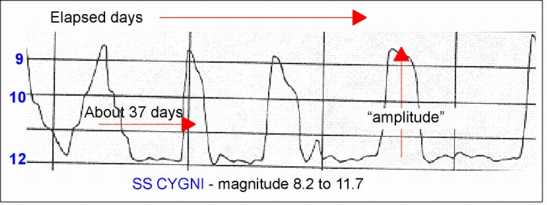
Even in this example for about four cycles, you can clearly see major differences in each period. SS Cygni is of the "dwarf novae" type (R Geminorum class) which is characterized by minor and predictable actual eruptions of the stellar "surface." Normally this star rests at magnitudes of about 11.8 to 12.0, but at intervals which can range from two dozen to nearly 100 days, it will suddenly and briefly erupt to its full brightness. Some maxima will last for a full 18 or 20 days, while others only about 8-10 days....but you never know which to expect. That is why this star is so interesting.
Because of its short cycle and the brightness range is in reach of all of the telescopes (although during its faintest part of the cycle it might be beyond the reach of the ETX 60 and 70) and the ease of which it can be located with the American Association of Variable Star Observers' (AAVSO) "reversed" chart which duplicates the mirror-image field of Maksutov and Schmidt-Cassegrain telescopes, this is an inviting and rewarding object for your efforts. Download the following chart from the AAVSO, save to file, bring up and resize to your page and print a full-sized star finder chart complete with verified comparison star magnitudes to begin YOUR research on this exciting star:
http://charts.aavso.org/CYG/SS_CYG/SSCYG-B.GIF
This chart is the "b" chart, or moderately wide field and low power view. For the ETX 60 and 70 and if you are new at locating and estimating variable stars, you might wish to download the "a" scale (wider field) chart from the AAVSO that will assist you in finding the star. Also note that, when SS Cygni is faintest, it might be good to move up to the "c" chart which closes in on the star and its proximity, showing fainter comparison stars and a more narrow field of view. Both of these charts are available on-line through the same address. Proper methods of observations can be found, along with a full discussion of variables from my guide: "Observing Variable Stars" at: http://www.weasner.com/etx/ref_guides/variable_stars.html.
It is now know that SS Cygni is a binary star, as probably all U Geminorum "dwarf novae" star are likely. One component is a yellow dwarf star being encircled by a hot blue star, this thought to be the responsible star for the sudden outbursts as fresh gases from the yellow star stream gravitationally onto the hot surface of the intense blue star.
Object 7 - Cygnus X-1
In our last "GO TO" TOUR of the constellation Scorpius, we looked at our first "unseen" object, the highly intense X-ray emission of Scorpius X-1, a very faint 13th magnitude object just at the limits of the ETX 125 and LX 90. Here we have one that you can actually "see," in Cygnus X-1. Probably a black hole - and listed as one on your AutoStar library of objects, Cygnus X-1 shows optically as a rather uninteresting 9th magnitude star. This is near the threshold of the ETX 60 and 70, but should be readily seen in the ETX 90 and larger scopes. It is only one-half degree ENE of the bright star Eta Cygni in the center of the swan. Recent studies show that the strong emissions from this star are NOT due to supernovae activity, but rather from a suspected "collapsed" object such as the black hole phenomenon. You can use the following photograph, courtesy Lowell Observatory (south at top), to locate this curious object. It MAY be the only "black hole" that you "never see."
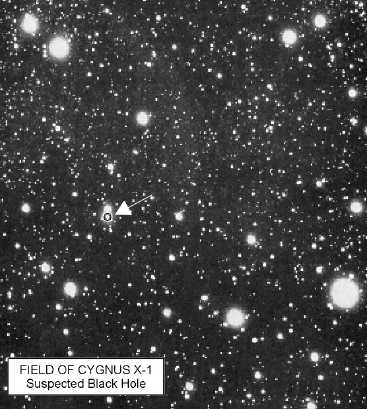
Object 8 - Very Nice Galactic Cluster in the Summer Milky Way - Messier 29
Only about two degrees SSE from Gamma Cygni, this nice galactic cluster, Messier 29 (ngc6913) is only one of dozens of such objects throughout Cygnus and this region of the Milky Way. You first impression in the ETX 60 and 70 will be a "rectangle" of equal brightness stars, surrounded by others scattered about the quadrilateral. There are about 20 stars in the 8th and 9th magnitude range, all visible in these scopes on a dark night. At about 1/3 the angular diameter of the moon, this is an easy object, although in larger scopes and at higher magnifications the "cluster" impression soon diminishes. So use the very lowest power and the widest field possible. This area of the Milky Way really deserves some scanning time, so deviate a bit from your busy GO TO schedule and stay a while. Messier 29 has always reminded me of a "little Pleiades", much smaller due to its great distance of 7200 light years (almost 200 times more distant that M-45!).
Object 9 - Another nice galactic cluster! - Messier 39
Messier 39 (ngc7092) is considerably closer (800 light years) than M-29, above and appears larger because of it. It was recorded as early as 320 B.C. by the Greek philosopher Aristotle, appearing as a glowing light in the sky, barely visible to his naked eye. It appears to me without any optical aid much like Messier 35, the large cluster in Gemini, except no so large. About 35 stars can be seen in this cluster, spread over a field about the size of the moon's diameter; hence, use ONLY low power and wide fields to observe. Stars can be resolved into component images in all telescopes, but the best image is likely afforded by the ETX 90 at about 50x. About twice as far as the close Pleiades, this cluster is probably about twice as old as well, still making it a very young group of entries into the stellar population.
Object 10 - THE FAMOUS "DUMBBELL NEBULA" in Vulpecula
To me, this object is still in the constellation of Cygnus, just southeast of the beautiful double Albireo and only 3 degrees due north of gamma Sagittae. Although it may not be as popular as another planetary nebula, the famous "Ring Nebula" in Lyra (see my constellation Guide "GO TO.... Lyra" at http://www.weasner.com/etx/ref_guides/lyra.html for complete details and drawings), this is the brightest and most conspicuous planetary nebula in the sky. It is very large (8' long by 5' wide) and appears to me shaped like a man's "bowtie" more than a "dumbbell."
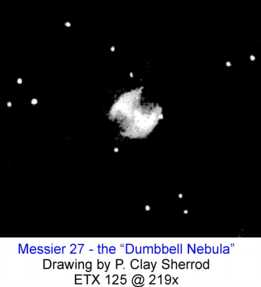
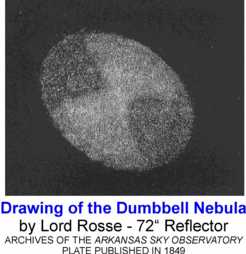
This drawing shows a very accurate rendition of the shape and visible detail of the Dumbbell in my ETX 125 at about 227x (the 4.7mm Ultra Wide Angle) under a very dark sky. Compare this to the mid-19th century engraving by Lord Rosse from his observations with the giant 72" reflector that was the giant of the world at the time. Because of the excitement over the newly-resolved globular clusters and some larger galaxy clusters, Lord Rosse apparently (and incorrectly of course) believe that the nebula was comprised of thousands of pin-point faint star images as can be seen dotted across his drawing. This drawing and MANY other similar engravings can be found in the classic book (1849) "Letters on Astronomy Addressed to a Lady in which the Elements of the Science are Familiarly Explained in Connection with its Literary History." WOW! You think the title is long....wait 'til you read the BOOK!
At about 850 light years, the large planetary nebula still exhibits its central star, the one whose explosion triggered the large shell of luminous gas that we see today. At magnitude 13.4, this star is almost equal to that "seen" in the Ring Nebula, although I have routinely seen the central star of Messier 27 in an 8" aperture telescope with difficulty (very easy in the 24"), but the star within Messier 57 is extremely difficult. This is curious since the gas cloud in MORE concentrated in the Dumbbell than in the "hole" of the Ring Nebula.
In the ETX 60 and 70 use about 90x minimum to observe Messier 27 so that its distinctive shape can be appreciated. The star field surrounding it at that power is incredible as well. In the ETX 90, the best views are provided at around 90x to 120x. My most satisfying glimpse with the ETX 125 and LX 90 has always been with pretty hefty power - 227x.
Objects 11 - Two Gossamer Arcs of Nebulous Strings: ngc6992 and ngc6960, the "Veil Nebula"
This is a remarkable object that shows up very well on piggyback photographs of wide field constellation shots of Cygnus. These two diffuse gas clouds (actually one objects, the remnant of a ancient supernova explosion) are located in the far southeast corner of Cygnus, right at the border with Vulpecula, and only a few degrees north of the planetary Messier 27 (above). Although it took an 18" telescope 200 years ago to find this object, it can be seen in modern scopes today; if you have very dark skies, no moon and the ETX 125 or LX 90, you can spot this arc of nebulosity in its true shape. LOW POWER is a must, as higher magnification increases sky contrast to mask out the faint clouds of gas. NGC 6992 is the brighter of the two and will appear on the "upper right" (northeast portion) of the field of a wide angle view; the dimmer object, NGC 6960 is a real test for the ETX 125 but can be held steady in the LX 90 in dark skies. Both appear to be semi-circular arcs of very faint light that "almost" intersect with one another visually. In all this object is a ring of gas debris almost 3 degrees in diameter! It is believed to be the shell of yet another supernova blast from a now-annihilated star some 150,000 years ago.
Object 12 - Very nice, small glittering of stars: Galactic Cluster ngc6866
Although not an easy object, this very small (only 6' arc) galactic cluster of some 50 stars is located nearly due west of the "heart" of the northern cross. In the ETX 60, 70 and 90 expect only some 10 stars to be clearly distinguished, with the remaining appearing as an interesting glow among an absolutely breath-taking star field. Use about 25x per inch for best views of the cluster in all scopes, but much less magnification and wider field to scan the star field around it. In the ETX 125 about 20 stars can be seen clearly and about 10 ore in the 8" aperture. This is a very tiny object, but one worth looking for. At first, at very low magnification (which is the best way to locate it) it will appear only as a faint glow like a little comet without a tail; only with some "power" will you begin to make out individual stars.
Object 13 - The NORTH AMERICAN NEBULA! - ngc 7000
Somehow, perhaps as a fitting tribute to Uncle Sam, this remarkable diffuse reflection nebula was one of the "lucky NGC objects to get the "millenium index," the even-numbered designation of "7000." After seeing wonderful photographs of this objects, most amateurs expect to be able to see it. After all: it is easy to find (only 3 degrees east of bright Deneb!); it is HUGE...120' arc x 100' arc!; and it is bright - 1.33 magnitude. Ahhh....but the downside to all this is, indeed its SIZE. It is so large that the brightness is spread over a surface area more than 90 times that of the entire moon! So you are lucky to see it once in a lifetime.
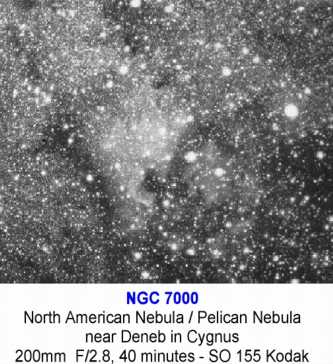
This object is one in which the ETX 60 and 70 can beat the rest of them hands down. Using incredibly low power and ONLY on the darkest night atop some remote mountain....no moon....this object will stand out in an almost 3-D appearance against the brilliant star dust skies of the Milky Way; it can be seen in a very good pair of 10 x 50 binoculars under idea conditions. Wide field, piggyback photography (see http://www.weasner.com/etx/ref_guides/astrophotography.html for my introduction in to piggyback photography and how easy it is with your ETX or LX 90 scope!) reveals the entire nebula, including the "Pelican nebula" (to the lower right in the above photo....the "pelican" facing Mexico!) and even the dark "Gulf of Mexico!" complete with the Yucatan Peninsula!
Object 14 - A Fine Double Star in Delphinius....Gamma Delphini
At magnitude 3.9 this is perhaps the most interesting object (and a good one!) in our celestial Porpoise. Gamma Delphini makes up the northeast "corner" of the small diamond comprising the "body" of the dolphin. With a nice wide separation of 10" arc and two fairly bright stars (magnitudes 4.3 and 5.1) this is an outstanding object for all telescopes, but particularly nice in the ETX 60, 70 and 90. I find the brighter star to be somewhat "orange" color and contrasting nicely with the dull white or even "gray" color of the fainter star. It truly is a very nice double for contrasting and interesting color combination. For these telescopes, it is recommended to use about 80x to 100x for best views and renditions of color. For the ETX 125 and LX 90, there is a challenging double star just 15' arc (half the moon's diameter) due south of this pair. At magnitudes 7.5 and 8.0 this evenly matched double is about 5.7" arc separation, so it CAN be resolved with the ETX 90 as well in good skies. Best resolution will occur at about 25x per inch aperture on this faint star, located at R.A. 20h 44' / DEC. +15 degrees 43'; it can be spotted in the very same field with Gamma Delphini in low power.
--------------------------------
WANDERING ABOUT....YOUR NEW "USER OBJECT" IN DELPHINIUS
THAT'S RIGHT....not Cygnus. Delphinius. And there is a reason for it. If we do NOT put a User Object into your AutoStar library in Delphinius....you may NEVER look at anything in that constellation again! it's a DOLPHIN for crying out loud! Show your support for our intelligent watery counterparts and their fragile existence in the environment! GO TO a double star on the fish's snout! Get the coordinates for Gamma Delphini (above) And LET'S LOAD THIS beautiful double star INTO OUR USER OBJECTS! Take your Autostar and key in the particulars for "Gamma Del." This will likely be your ONLY user object for the constellation of Delphinius if you are like me.
On AutoStar, go to: "Select/Object [enter]...." scroll down to "User Object" [ enter]. Now enter the coordinates given above for "Gamma Delphini", using the number keys on AutoStar. After entering and pressing "Enter" yet again, scroll down one and you can list the magnitudes of both stars [Enter].
Next Constellation GO TO" TOUR Installment: AQUILA the Eagle, containing what is surely my favorite galactic cluster (well, other than the Pleiades which really should not count. In this wonderful majestic soaring celestial Eagle we will examine the rich and thick clouds of stars that comprise the most dense portion of our Milky Way galaxy as we move every-so-closer to the galactic center in the famed archer Sagittarius.
Good Observing and explorations of this wonderful world of deep space!
P. Clay Sherrod
Arkansas Sky Observatory
Conway / Petit Jean Mountain
Arkansas
http://indigomerovingianfrankfish.blogspot.com.ar/

